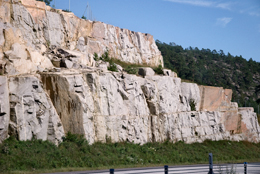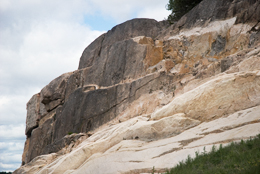For Uvedale Price the picturesque was something intermediate between the beautiful and the sublime precisely because it involves our experience of the ordinary – that which neither pricks the nerves to fear nor leaves them unnecessarily relaxed; the mundane, complex landscape we see in our everyday lives. For it was the experience of the ordinary in nature that Price sought to describe; undisturbed ground of the very kind we sometimes find in road verges, provided they haven’t been subjected to “levelling”. The picturesque road allows us to discover “the different strata of the earth, and the shaggy roots of trees” – not to mention “the varied tints of the soil”. In other words, for the pristine condition of the earth to be exposed, the landscape has to be worked upon.
 The landscapes we get to see in Book & Hedén ’s pictures are products in a double sense – firstly of the bulldozers of the Directorate of Public Roads, secondly of the camera. The photographs freeze the images that in reality are snatched away by the vehicle’s velocity – still glimpses of sights we tend to pass at high speed and hence are unable to see in detail. They present completed views that can be studied, their artificiality emphasised by their seemingly manipulated and distorted perspective.
The landscapes we get to see in Book & Hedén ’s pictures are products in a double sense – firstly of the bulldozers of the Directorate of Public Roads, secondly of the camera. The photographs freeze the images that in reality are snatched away by the vehicle’s velocity – still glimpses of sights we tend to pass at high speed and hence are unable to see in detail. They present completed views that can be studied, their artificiality emphasised by their seemingly manipulated and distorted perspective.Some of the photographs have a profoundly theatrical aspect. They involve three ingredients: rock, the sky with its clouds, and vegetation, the three principal elements of romanticism applied to an everyday landscape. In some of the pictures, the clouds are fluffy and well formed, floating powerfully and elegantly across the sky. Beyond this, the drama of romanticism is evident in only one of the images; the rock face is wet, glistening dark and precipitous. In another we see the contrary – a charming little tableau exhibit of stone, trees and sky. The rock has an almost artificial blue tinge, suggestive of an object on display, set among the grass a short distance from the road.
The proportions are also deceptive; several of the rock faces look like mountain ranges. One of them resembles a mountainside in Yosemite, the national park in California’s Sierra Nevada district. The colour and smoothness of the granite is very similar – it is one of few cuttings in the series where the type of rock has few natural faults; the surfaces are extensive and look as soft as silk. But it is perhaps in this image that the grass cover along the picture’s lower edge most resembles a forest, thus magnifying the scale of the mountain. The dimensions in another picture in the series seem impossible to determine. This could be either a jagged mountain range or a massively enlarged detail of a small stone. Yet another image shows a dramatic structure that resembles inhabited and terraced hillsides in some desert region.
 The closeness of the camera to the rock often produces a surprising effect – the stone appears soft, as if it had an utterly different materiality. One of the blasted rock faces looks like heavy velvet drapery unfurling down a cliff. Others seem unfinished, with deposits of soil and rubble heaped up against the wall. The “decorative” green grass cover typical of motorway verges across large parts of Europe has not yet been planted and the traces of construction work are still clearly visible. The substrate lies exposed as something utterly unfamiliar prior to the final stages of landscaping, and thus lacks the characteristic of evenness that Uvedale Price described as a threat to the picturesque relationship to the “ground itself”.
The closeness of the camera to the rock often produces a surprising effect – the stone appears soft, as if it had an utterly different materiality. One of the blasted rock faces looks like heavy velvet drapery unfurling down a cliff. Others seem unfinished, with deposits of soil and rubble heaped up against the wall. The “decorative” green grass cover typical of motorway verges across large parts of Europe has not yet been planted and the traces of construction work are still clearly visible. The substrate lies exposed as something utterly unfamiliar prior to the final stages of landscaping, and thus lacks the characteristic of evenness that Uvedale Price described as a threat to the picturesque relationship to the “ground itself”.Even so, these photographs possess a powerfully documentary aspect. The cliff faces come across as examples of the topologies one finds exhibited in Scandinavian nature. They consist of various types of granite and gneiss. In one of the pictures in particular we see a typical example of stratified gneiss – horizontally undulating patterns of grey with streaks of white. In some of the pictures we see clear traces of hypabyssal rocks forced up into older rock types forming conspicuous transverse gullies of a paler tone. The colour and texture of the stone surfaces is determined by their mineral composition – for example, by a mixture of quartz, mica and calcium feldspar, the components that make up granite. Golden-red and pink hues are typical of Nordic granite with a high calcium feldspar content.
The series carries out observations of the motorway landscape from a car moving at speed. And the object of the observations is something other than the landscapes that William Gilpin observed and described for English travellers in the 1780s in his Observations on the River Wye – views that are not picturesque so much as ordinary, shaped by road work activities – work that brings us into close contact with the unshaped ground.
read more
